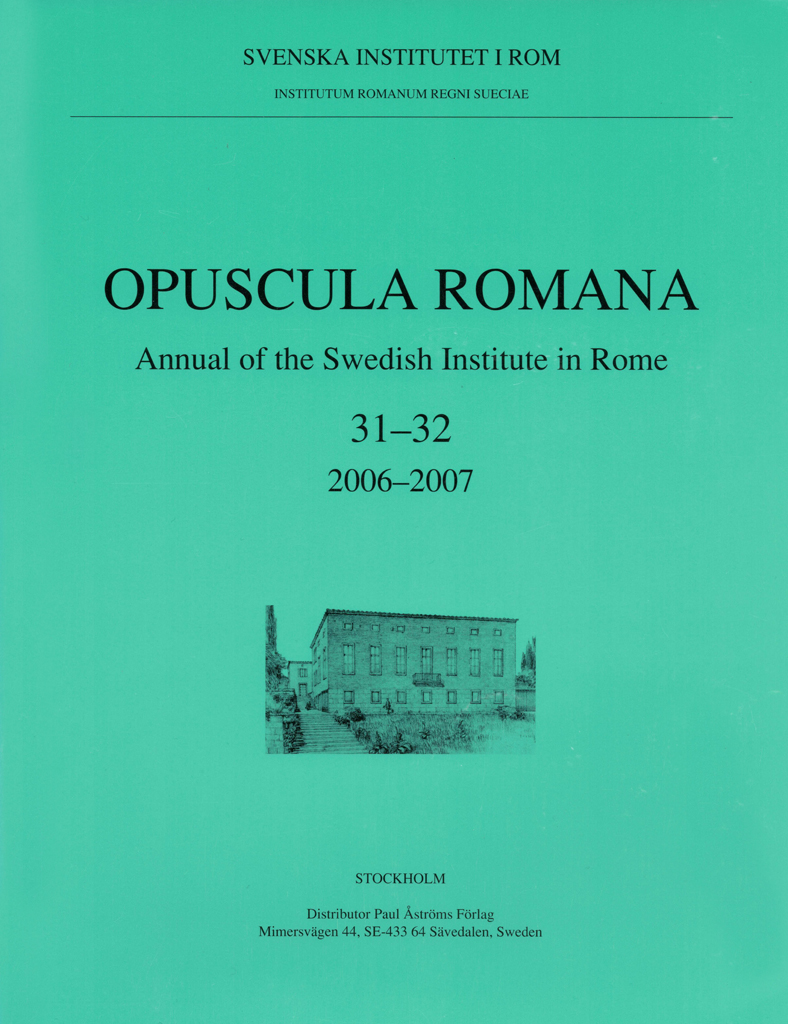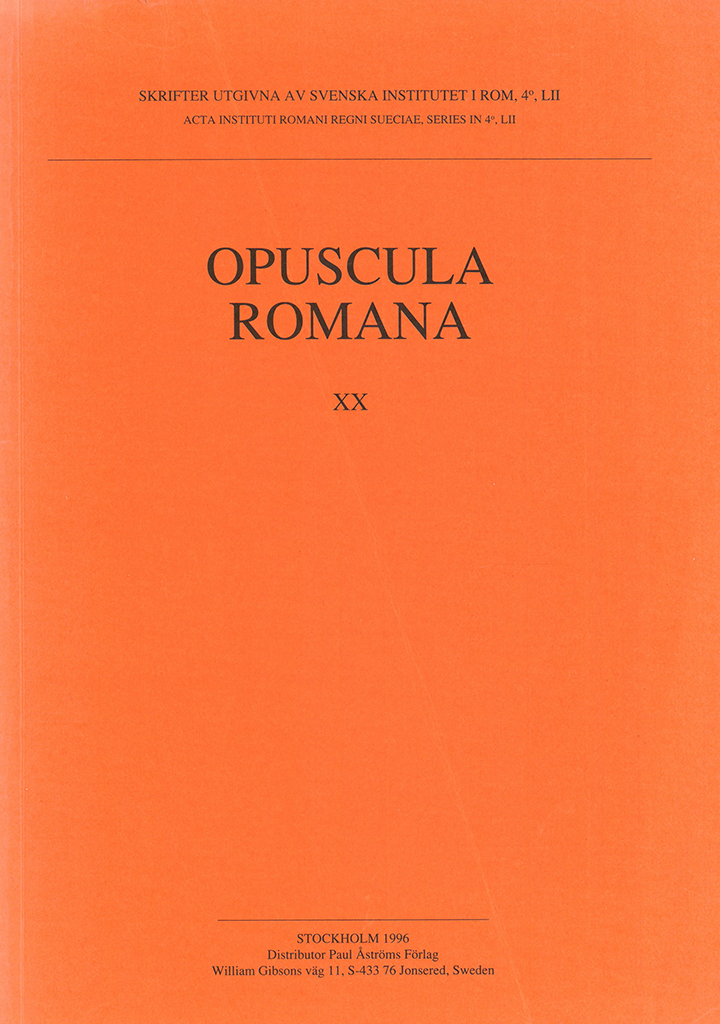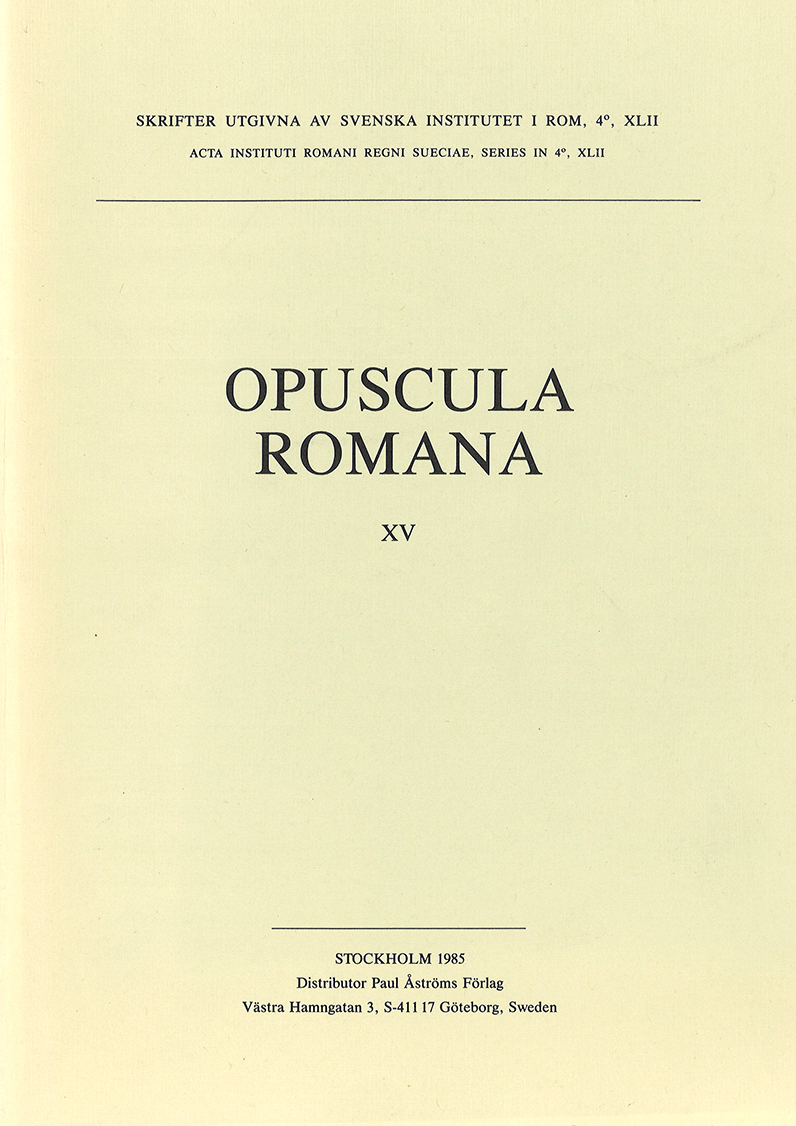Now available for purchase at Amazon.com, Amazon.de, Bokus.com, Adlibris.com, and Bokorder.se. Contents Johnny R. Bengtsson | Late Bronze Age handles from the Apennine settlement at Luni sul Mignone: Some chronological observations Ingela M.B. Wiman & Yvonne Backe-Forsberg | Surfacing deities in later Etruscan art and the sacellum at San Giovenale Allan Klynne | The Villa Selvasecca revisited John W. Hayes | Villa Selvasecca: the pottery finds Ebba Engström & Ragnar Hedlund | Villa Selvasecca: the coins Dominic Ingemark | Villa Selvasecca: the glass Anne-Marie Leander Touati | Interim report of the Swedish Pompeii Project: Work 2000–2004/5 in Insula V 1. Introduction Margareta Staub Gierow | The House of the Greek Epigrams V 1,18.11–12: preliminary report 2000–2004 Arja Karivieri & Renée Forsell | The House of Caecilius Iucundus, V 1,22–27: a preliminary report Henrik Boman & Monica Nilsson | The commercial establishments V 1,13; V 1, 14–16; V 1,20–21: preliminary report 2001–2004 Mark Robinson | Evidence for garden cultivation and the use of bedding-out plants in the peristyle garden of the House of the Greek Epigrams (V 1, 18i) at Pompeii Henrik Boman & Monica Nilsson | The early street and the prehistoric finds in Vicolo delle Nozze d’Argento, Pompeii Jörg…
Published by the Swedish Institute of Classical Studies in Rome. Distributed by Astrom Editions. Opuscula Romana 20. Pär Göran Gierow dedicata Contents Kristina Berggren, Tre tombe a cremazione con trace di legno nella necropolis di Quattro Fontanili a Veio (Roma) Ingrid E.M. Edlund-Berry, The power of cults and sacred spaces. The interpretation romana of sanctuaries in southern Italy and Sicily Maria C. Eriksson, Two Etruscan mirrors in the Thorwaldsen Museum, Copenhagen Björn Forsén & Timo Sironen, Bolli laterizi romani nell’Antikmuseet in Göteborg Lena Landgren, The Roman pleasure garden—foundations for future studies Peter Liljenstolpe, De ornamentis templi Urbis. Reconstructing the main order of the temple of Venus and Roma in Rome Alessandro Naso, Osservazioni sull’origine dei tumuli monumentali nell’Italia centrale David Ridgway, Greek letters at Osteria dell’Osa Paavo Roos, Strabo and the water-mill at Cabeira. Some considerations Raffaele Santillo, Il «saxum ingentem» a Ravenna a copertura del Mausoleo di Teoderico: problemi e soluzioni Martin Söderlind, A central Italic, terracotta votive head in the Classical Museum of Antiquities in Lund (in association with Pierluigi Bianchetti, technical analysis) Margareta Strandberg Olofsson, Pottery from the monumental area at Acquarossa: a preliminary report Bengt E. Thomasson, Laterculi praesidium. Addendorum series altera Örjan Wikander, Senators and…
Opuscula Romana 15 Published by the Swedish Institute of Classical Studies in Rome. Distributed by Astrom Editions. Contents Patrikk Bruun, ‘From polis to metropolis. Notes on Thessalonica in the administration of the Late Roman Empire´, pp. 7–16. Lucos Cozza, ‘La grande pianta di Falerii esposta nel museo di Villa Giulia’, pp. 17–46. Ingrid Edlund, ‘A terracotta head from Poggio Civitate (Murlo)’, pp. 47–53. Harry Erkell, ‘Varroniana II. Studi topografici in Varro, De lingua Latina V, §§45–50’, pp. 55–65. Hack Kampmann, ‘The ustrinum in Palazzo del Parlamento in Rome’, pp. 67–78. John Kraft, ‘The Cretan Labyrinth and the walls of Troy. An analysis of Roman labyrinth designs’, pp. 79–86. Anne-Marie Leander Touati, ‘A marble head in the Swedish Institute in Rome’, pp. 87–92. Hugo Montgomery, ‘Decurion and clergy—some suggestions’, pp. 93–95. Eva Rystedt, ‘An unusual Etruscan vase from Chiusi’, pp. 97–104. Charlotte Scheffer, ‘Was there a garden at Poggio Civitate?’, pp. 105–108. Bengt E. Thomasson, ‘Zur Laufbahn einiger Statthalter des Prinzipats’, pp. 109–141. David Whitehouse, ‘Medieval pottery from Luni sul Mignone’, pp. 143–147. Örjan Wikander, ‘Mill channels, weirs and ponds. The environment of ancient watermills’, pp. 149–154. Örjan Wikander, ‘Senators and equites. I. The case of the Aufidii’, pp. 155–63. Guide…
Luni sul Mignone. Results of excavations conducted by the Swedish Institute of Classical Studies at Rome and the Soprintendenza alle Antichià dell’Etruria Meriodionale Published by the Swedish Institute of Classical Studies in Rome. Volumes published 2007 and earlier distributed by Astrom Editions. Volumes published 2008 and later distributed by Eddy.se AB. Vol. 1 not yet published Vol. 2. Excavations and finds. Iron Age, Etruscan, Roman and Medieval periods Fasc. 1. Torgun Wieselgren 1969. The Iron Age settlement on the Acropolis, Lund (softcover: 111 pp.). Luni sul Mignone, the small hill which will be remembered for its important remains from the Bronze Age and for the Monumental Iron Age building, has also brought to light less important remains from the latter period, which will be dealt with in the present report. It was during the third Luni campaign, led by Dr Carl Erik Östenberg on behalf of the Swedish Institute in Rome, that I was asked to undertake an excavation on the NE side of the Luni plateau. In the hope of finding remains of habitation we started where there still seemed to be enough earth to produce a stratification, since higher up where the earth-layer was only 20-15 cm deep,…
Luni sul Mignone e problemi della preistoria d’Italia By Carl Eric Östenberg Published by the Swedish Institute of Classical Studies in Rome. Distributed by Astrom Editions Summary (excerpt) The Swedish Institute in Rome, in collaboration with the Soprintendenza alle Antichità dell’Etruria meridionale, started excavating the site named Luni in 1960. The field work went on with annual seasons lasting 2 months during the following three years, and gave interesting results concerning several periods of Italian prehistory. Luni is situated in the Comune di Blera, Provincia di Viterbo, about 80 kilometres north of Rome and about 20 kilometres inland from Tarquinia, in a district at the foot of the Tolfa Mountains which is nowadays isolated but beautiful. The 550 m long and 140 m wide tuff plateau is separated from its surroundings, with steep sides sloping to the river-eroded valleys on each side. In the Etruscan period it was a military outpost on the southern border of the territory belonging to Tarquinia, fortified in the 5th century B.C. by a city wall, defensive ditches and a castle. The river Mignone that flows just below Luni was the boundary between Tarquinia and Caere. The hill is still called Luni by the inhabitants…





